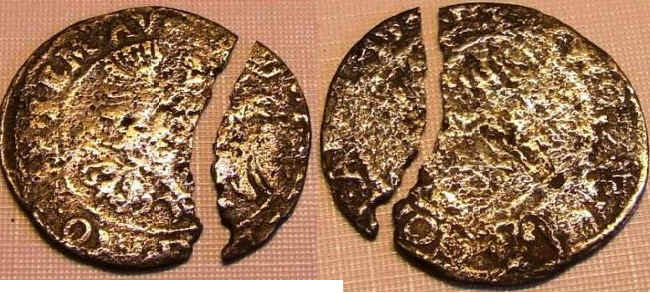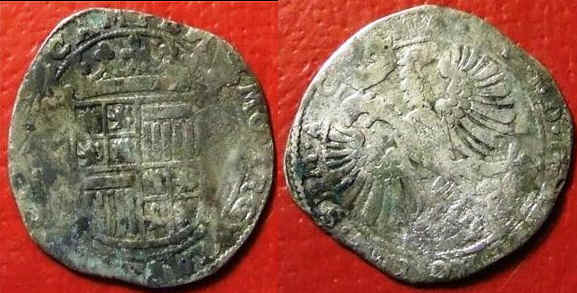Zilveren arendschelling Merestein
 |
AREND SCHELLING !!!
SALVAGED AFTER 300 YEARS BELOW THE OCEAN !!!
UNDATED
FROM THE 1702 SHIPWRECK OF THE "MERENSTEIN"
SANK WITH MAJOR LOSS OF LIFE AT JUTTEN ISLAND ,SALDANHA SOUTH AFRICA SALVAGED IN 1976 BY
FAMED TREASUE AND WRECK-HUNTER BOBBY HAYWARD OF CAPE TOWN. THIS IS A TIPICAL SHIPWRECK
COIN. US $12,16 (EUR 9,41), 18-nov-06, ebay, joubero |
 |
1600's silver V.O.C Shipwreck Coin, MERESTEIN,schelling US $101,00 (EUR
68,49), 06-aug-08, ebay, joubero |
VOYAGE NR: 1869.4 NAME OF VESSEL: Merestein
The MERESTEIN, a Dutch East Indiaman, was typical of the many merchant ships which
plied the Atlantic and Indian Oceans trading and carrying troops to Batavia and elsewhere
during the latter years of the seventeenth century. The vessel was built at Amsterdam in
1693, having been commissioned by the Amsterdam Chamber of the Dutch East India Company.
In length she measured just over one hundred feet (145 'Amsterdamse' feet), with a loading
capacity of 315 English tons (160 Dutch 'lasten'), and made her maiden trip in 1694,
departing for the Indies on 6 June and returning on 11 November 1695.
Her next two voyages for the Indies were commissioned by the Enkhuizen Chamber of the
V.O.C. on 20 July 1696, and by the Rotterdam Chamber on 15 April 1699. The last time she
left the Texel roads in the Netherlands was on 4 October 1701, to meet her fate exactly
six months later on the treacherous rocky shoals off Jutten Island, some 65 miles NNW of
Cape Town.
The MERESTEIN had left Texel on 4 october 1701 on a trading mission to the East heavily
laden with a valuable consignment of silver specie for Batavia. Many of those on board
were sick with scurvy and it was the urged need for fresh water and fresh victuals which
brought the ship close to the South African coast while still a considerable distance
north of the Cape. As he approached land, Captain Jan Subbinga recognised the entrance to
Saldanha Bay, which was regularly used as a watering place for the Company's ships.
But, finding himself close into the shore, he unwisely decided to take the narrower and
more treacherous southern channel between the island and Jut Point. Suddenly came the cry
"Breakers ahead!". A south-westerly wind was blowing and the order was given to
sail the ship into the wind; the sails were consequently shortened, but the vessel failed
to answer her helm properly. Captain Subbing ordered an anchor to be dropped, but this
failed to steady the vessel, and he ordered another.
At this point the sails filled with wind and the chief mate suggested that the anchor
lines be cut, so that the vessel could be brought about. However, Subbing first called a
council of his officers, but as result of the delay the vessel ran aground on the
south-west corner of the island, and only 99 of her crew of 200 managed to save
themselves.
Within an hour of her striking underwater reefs on the evening of 3 April 1702, the
ship was pounded to pieces by the great waves. When morning came, nothing of the MERESTEIN
showed above water. The survivors gazed at the wreck site from the safety of the island,
but all they could see were a few planks floating over her grave.
The first team of divers to attempt a serious salvage of the wreck arrived at the
island in 1971. The leader of this group was Bobby Hayward of Cape Town, a well-known
commercial diver with a great interest in history
The MERESTEIN is typical of a wreck on an open-coast surf-line site. The wreck site on
the south-west site of the island is an extremely exposed area which is completely at the
mercy of the huge ground swells that periodically pound the shore. Very little timber from
her hull has been found, and this is understandable, as the hull completely disintegrated
in the heavy surf at the time of the wrecking, the timber beiing washed ashore on the
island and on the beaches in the vicinity. Some idea of the velocity of the wave action on
the site can be gained by noting the position of a cast iron cannon, high above the
waterline. Furthermore the site is blanketed with red-bait pods and in the deeper crevices
kelp covers the rocks.
The salvage party began systematically searching through the gullies and crevices and
discovered banks of red matrix consisting of lime, iron oxide and broken glass carpeting
the bottom of the deeper crevices. They had to wait patiently for flat conditions and
during the few calm days allowed them they blasted and chipped away at the beds of the
conglomerate, and, to their amazement, found encased in it the legendary silver treasure
of the MERESTEIN.
The only coins which had survived in a perfect state of preservation were those which
were completedly embedded in the concretion. After cleaning, these coins proved the
MERESTEIN to be the most important coin wreck found on the South African coast. Ducatoons,
silver riders and Dutch shillings dating back to the late 16th century were found in great
numbers. These coins were all hand-stamped and had obviously been withdrawn from
circulation in Europe. They proved a delight to collectors, as they are works of art in
themselves; some were of the highest rarity. The coins which had not been encased in the
matrix were badly corroded; some were worn paper-thin, of intrest only to metal dealers.
Besides the silver coins, a few gold ducats were found, but not in great quantities.
The wreck lies within the harbour area of Saldanha Bay and diving is only allowed with
the permission of the Port Captain. Her remains are scattered on the islands shore at
depths ranging from 3 to 6 m.

